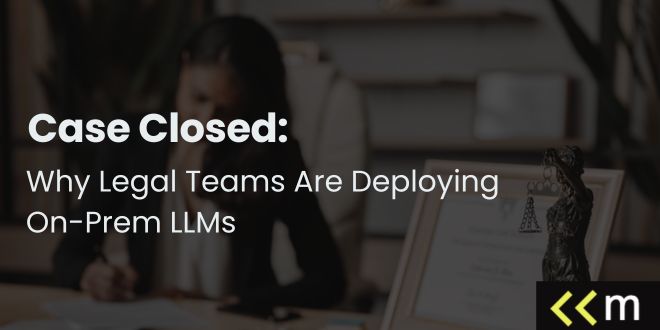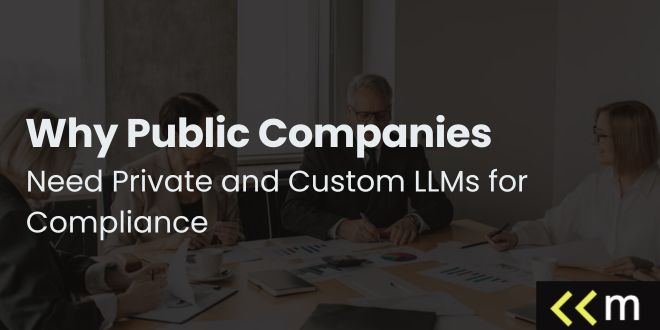Case Closed: Why Legal Teams Are Deploying On-Prem LLMs

Legal teams are famous for caution, not fads, yet they see the power of the Large Language Model when it is handled with care. The trick is to bring that intelligence inside the walls, where confidentiality and control feel less like a promise and more like a policy. On-prem LLMs give firms and in-house departments a way to modernize without surrendering privileged data, and they do it while keeping regulators, auditors, and skeptical partners comfortably unruffled.
The Case for On-Premises Adoption
Privacy and privilege set the tone for everything in legal work. When a model runs on infrastructure you own or tightly govern, sensitive content never leaves the estate. That single shift reduces exposure, simplifies vendor reviews, and aligns with client expectations about who touches their data.
Client Confidentiality Comes First
Attorney-client privilege is a fortress built on custody. Hosting the model inside controlled environments preserves that custody, limits the number of processors, and trims the attack surface. Outside inference endpoints and pooled training pipelines introduce uncertain hands. Inside deployment keeps the circle small and the paperwork shorter.
Regulatory Comfort and Data Residency
Legal work spans regions and industries, each with its own privacy requirements. On-prem deployments make it possible to anchor data in defined locations and verify compliance. Residency controls ensure content stays where it should. Encrypted storage adds protection, while detailed logs make access transparent. Together, they show exactly where the data lived and who had visibility.
Determinism, Latency, and Quality Control
Lawyers dislike surprises, both in court and in outputs. Local inference reduces latency and lets teams fix versions of models, tokenizers, and prompts so responses are reproducible. Tighter feedback loops make it easier to compare drafts, tune guardrails, and document why a change improved outcomes.
Risk Management Meets AI Governance
Legal teams already live inside risk frameworks. Extending those habits to model governance feels natural. The goal is to prevent accidental disclosure, manage bias, and prove that controls are real. Good governance is invisible to end users, yet it keeps leadership comfortable signing their name.
Access, Roles, and Segmentation
Treat the model like a sensitive repository. Map matters to projects, grant least-privilege access, and isolate training and inference from general office traffic. Small, boring steps pile up into meaningful protection.
Data Minimization and Retention
Feed models only what is required. Mask names, drop irrelevant fields, and separate drafts from gold source. Retention policies should match the matter lifecycle, with defensible deletion when work is done. If you would not put it on a conference room projector, do not ship it into a context window.
What On-Prem Actually Means
On-prem is not a fortress of humming servers and late-night heroics. It spans everything from air-gapped racks to private clouds with strict tenancy controls. The purpose is to enforce your policies across network, storage, and identity layers, while preserving the flexibility to scale.
Deployment Patterns that Work
Many teams start with a private cluster that hosts inference endpoints, vector databases, and orchestrators behind a zero-trust gateway. Storage is encrypted at rest and in transit, keys sit in a hardware module, and every request is tied to a user. Logs capture prompts, outputs, and citations with scrubbed content so analysis can happen without exposing secrets.
Retrieval over Memorization
Rather than stuffing models with everything you have, pair them with retrieval systems that read from approved sources. Contract playbooks, policies, and templates live in document management systems. The model retrieves relevant passages, drafts with them, and cites what it touched. That keeps knowledge current and limits drift.
Fine-Tuning, if You Really Need It
Lightweight adapters and well-designed prompt templates are enough for most legal tasks. When fine-tuning is required, the training sets should remain small, precise, and stripped of any privileged details. Every example must be tracked for provenance and license terms to ensure compliance. The focus should be on building capability, not exposing sensitive information. The goal is skill, not noise.
Accuracy, Hallucinations, and Guardrails
The fastest way to lose trust is a confident wrong answer. Guardrails do not have to be fancy to be effective. They must be consistent, testable, and visible to reviewers.
Structured Prompts and Role Clarity
Shape requests so the model knows what to do, what to cite, and what to avoid. Provide matter identifiers, jurisdiction, and the desired depth of analysis. Ask for uncertainty flags when the model is not sure. A little self-awareness goes a long way.
Validation before Delivery
Run outputs through validators that check citations, dates, and defined terms. Require a human reviewer for anything that leaves the firewall. Where possible, compare summaries against ground truth snippets. Validation is quality control for language.
Explainability that Matters
Full transparency into weights is less important than consistent reasoning artifacts. Capture decision paths, source links, and confidence scores. Give reviewers the context to accept, edit, or reject with minimal guessing.
Buying Criteria that Survive Procurement
Procurement looks for value that lasts beyond the moment. They want solutions that hold up over time and deliver measurable impact. Lock-in to a single vendor is a risk they work hard to avoid. True value is durable, flexible, and free from unnecessary dependence.
Open Ecosystem and Portability
Prefer models and tooling that follow common runtimes and export formats. Containerized deployment and standard vector stores make migration possible. If switching vendors feels like moving a piano, reconsider.
Security Essentials Without Exceptions
Look for native support for single sign-on, device posture checks, granular logging, and incident response hooks. Ask how secrets are stored, how patches are rolled out, and how tenant isolation is enforced. If answers wilt under follow-up questions, keep walking.
Hardware Reality Check
Not every matter needs top-tier GPUs. Profile workloads, rightsize hardware, and plan for bursts. Sometimes CPUs are enough for classification and routing, saving the big cards for heavy drafting and search.
Use Cases that Pay Off Quickly
Small wins carry real weight. They create momentum by reinforcing the right habits. Each step forward builds confidence and proves the approach works. And they do it quietly, without the risk of unwanted headlines.
Intake, Triage, and Routing
Route new documents to the right workspace, detect sensitive content, and propose tags that match your taxonomy. Early structure shortens timelines and helps reviewers find needles without wrestling the haystack.
Contract Review and Clause Guidance
These systems can parse clauses, flag unusual language, and propose positions aligned with the playbook. They can also link directly to precedent and policy for support. The reviewer remains firmly in control of decisions. But the first draft arrives organized, consistent, and ready for review.
Discovery and Investigation Support
Compose search strings, cluster similar documents, and map entities across custodians. Provide short, cite-backed summaries so teams can prioritize what to read next. No one mourns the hours they did not spend sorting duplicates.
Privacy by Architecture
Security is not a mood. It is a set of choices that hold up when someone asks hard questions. Encrypted storage, private networks, and strict identity controls should be table stakes. Layer monitoring that can spot unusual prompt patterns or data spikes. Keep encryption keys in hardware modules, rotate them, and separate duties so no single admin can see everything. Practice incident drills so people know who calls whom and in what order.
Limitations and Common Myths
On-prem is not a universal solution. It cannot erase every challenge or simplify every complexity. What it does offer is meaningful control—over data, access, and compliance. That control is a powerful advantage for organizations that value security and oversight. But it should never be mistaken for a magic fix.
You Still Need Humans
These systems can draft, organize, and highlight what matters. What they cannot do is give final approval. Legal judgment still rests with people, by design. That human oversight is not a flaw, it is the safeguard.
Models Change Fast
Plan updates carefully so evaluations and workflows remain intact. Rely on version pinning to keep stability and use staged rollouts to manage risk. Change will always come, that part is certain. But with foresight, surprises don’t have to turn into setbacks.
Conclusion
On-prem LLMs are not about nostalgia for server rooms—they are about trust, control, and documentation that reassures regulators. The approach is to bring models to your data, embed them within the safeguards you already enforce, and evaluate them with the same discipline applied to filings.
Start with small steps, prove their value, and scale only where they make work faster and more effective. The goal is not automation for its own sake, but stronger judgment delivered with less effort, in a framework legal teams can explain, defend, and keep confidently in-house.
Samuel Edwards is an accomplished marketing leader serving as Chief Marketing Officer at LLM.co. With over nine years of experience as a digital marketing strategist and CMO, he brings deep expertise in organic and paid search marketing, data analytics, brand strategy, and performance-driven campaigns. At LLM.co, Samuel oversees all facets of marketing—including brand strategy, demand generation, digital advertising, SEO, content, and public relations. He builds and leads cross-functional teams to align product positioning with market demand, ensuring clear messaging and growth within AI-driven language model solutions. His approach combines technical rigor with creative storytelling to cultivate brand trust and accelerate pipeline velocity.







